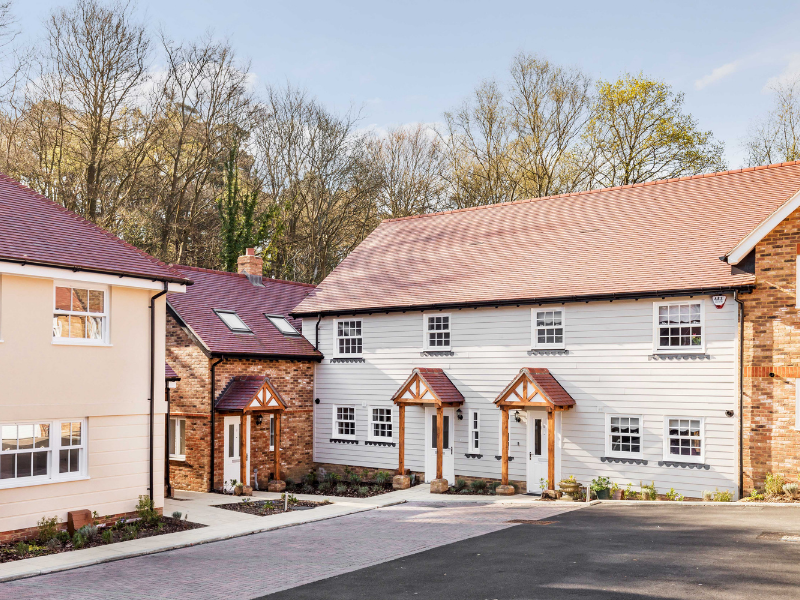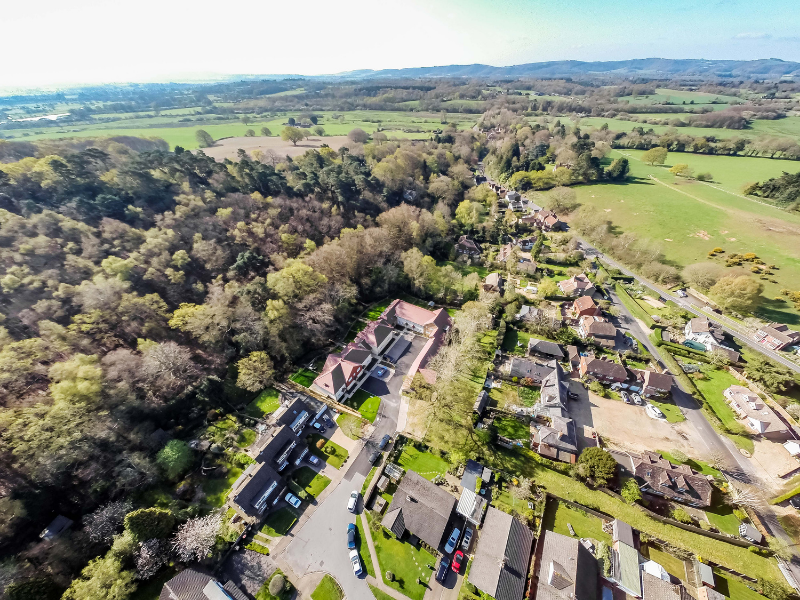4 minute read
Sigma Strategic Land (SSL) is in conversation today with Kris Mitra, a Chartered Town Planner with extensive experience in the South East of England. Kris has been a Managing Director for Genesis Town Planning since April 2009 and is based in Chichester, West Sussex.
Kris provides a broad range of planning services and insightful advice to a wide client base. This spans both immediate and strategic planning opportunities for a range of residential and commercial schemes. Kris has had particular experience with the South Downs National Park Authority (SDNPA) over a number of years.
SSL was keen to catch up with Kris to find out more…
- Sigma Strategic Land (SSL) is based in Horsham in the South East of England, a region which is very present with the South Downs National Park. The Park Authority was formed fairly recently in 2007 with the primary purpose to conserve and enhance its landscape quality. What do you see as being the main opportunities and challenges presented by the National Park?
The landscape quality of the National Park is very special and unique to the South Downs and underpins the landscape-led approach all development proposals within the National Park are required to take. There are very limited large scale development sites identified within the National Park, and the vast majority tend to be small to medium-sized developments. In my view, this presents a positive opportunity, because current sites that have a poor visual appearance and adverse impact on the landscape, such as brownfield sites on the edge of settlements or derelict and redundant agricultural buildings, can all be enhanced through conversion or redevelopment, with the sole objective of enhancing the landscape.
The improvement to the landscape becomes the driver for securing development that might ordinarily be a little ‘left of field’. There are many examples of sites throughout the National Park where this approach has been adopted. In many cases, the opportunity to create new residential development, which ordinarily would not have been possible, has materialised solely due to the positive impact on the landscape and setting of the park arising from the development proposed. We secured one such scheme at Graffham, where we were able to convert a range of Victorian farm buildings into 10 dwellings and demolish a bungalow and replace it with a much larger house. All this was predicated on a significant enhancement to the landscape by the removal of unsightly agricultural buildings, improvements to a public footpath, and enhancements to the landscape setting of the site. It was one of the very few schemes of this size and type to secure planning permission. However, one of the key challenges faced by many developers who work across a broad range of local authority areas within the National Park is securing consistency in decision-making and in the interpretation of SDNP policy. This is largely down to the agreements in place with district authorities to deal with applications on behalf of the SDNP, and a failure to often understand how policies should be interpreted or applied. Given time this situation should improve.

- It is often the case that developers and strategic land promoters see very little opportunity in the National Park given its emphasis on protection and comparatively low housing targets compared to the rest of the south-east. How do you view this situation given your experiences with the National Park Authority?
I am inclined to agree! There is very limited scope to identify large scale development sites within the core settlements of the National Park. However, like all authorities, the SDNP and those authorities which lie within the National Park are supposed to work together to deliver sufficient housing. There has unfortunately been a number of instances recently where even allocated sites within the SDNP have seen reasonable planning applications refused on density or landscape impact grounds, even though the sites are sustainably located.
Over the Plan period to 2033, the SDNP only has to provide 250 homes per year. How this will deliver the National Park’s social objectives of providing affordable homes and ensure the future vitality of the many towns and villages within it, remains to be seen. There are in my view opportunities to seek to promote the allocation of larger-scale development sites in locations on the periphery of the National Park border, particularly where such sites adjoin or are close to higher density settlements in neighbouring authorities. Such an approach can help to deliver potentially higher housing targets within the National Park boundary (and more affordable homes) but ensure that reliance for accessibility to services and facilities is available ‘cross-border’. In the event that the National Park sees an increase in its housing figures through the next review of the plan, this approach may appeal.
- The South Downs National Park is situated in the south-east where there are some of the highest housebuilding targets in England. How do you perceive this tension being reconciled, especially in light of London’s historic undersupply and pushing housing farther out and other built-up areas that are tightly constrained - either spatially or environmentally - in the region?
The fact that the National Park can, to some degree, hide behind its national status, helps to keep pressure for housebuilding beyond its boundaries. I often come back to that elusive footnote 7 at paragraph 11 (b) and (d) of the Framework, which seems to give the National Park a ‘stay of execution’ when it comes to identifying objectively assessed housing need, or in decision making, where there is a clear 5-year housing land supply deficit. Maybe I am reading too much into it!
- The SDNPA is one of the largest planning authorities in the UK in terms of the number of planning applications received each year and also one of the largest in terms of geographical area. This level of demand has seen new and innovative partnership models being established to ensure that planning-related matters are dealt with across Authorities. How do you see this role developing, especially in light of the Duty to Co-operate potentially falling away in the planning reform package?
My experience of dealing with a range of local authorities within the National Park boundary has been one largely of inconsistency and lack of clarity. It is an unfortunate situation which I believe largely emanated from the fact that the National Park Authority was never intending to operate like other National Parks, with the Park Board and Officers fully managing all applications within its administrative boundary. The extensive nature of the South Downs made that process difficult to manage, and the use of local authorities at a sub-regional level with designated Officers to deal with SDNPA applications within their area seemed sensible. I guess it works to a degree, but it’s not ideal. One of the biggest issues we have encountered is often a complete lack of understanding by Officers of the schemes proposed. Decisions are taken without recourse to professional consultees on landscape, heritage and other disciplines (often because they are not available), and applications refused on spurious and unjustified grounds. This delays and frustrates the system.
- Even with sites situated within close proximity to the SDNPA, particular consideration needs to be given to views in to and out of the Park. Its landscape influence is, therefore, a material consideration for a large number of schemes put forward in the wider area as well. What have your experiences been of this and do you have any particular advice?
As a general rule, the vast majority of planning applications we submit on behalf of our clients within the SDNPA will be accompanied by a full landscape and visual appraisal. This is the case whether the site is within or on the edge of the National Park. This comes down purely to the fact that decision making is landscape-led, and it is therefore critically important to get that aspect right from the outset. My advice would be to engage your landscape team early on in the process. This approach can help to smooth the scheme through the process.
- The South Downs Local Plan (2014 – 2033) was adopted in July 2019. Are there any planning policies worth highlighting which a developer, planning consultant or landowner needs to take particular care of?
There are plenty of policies I could highlight, but I may do so for the wrong reason! Policy SD 25 is interesting. It deals with the development strategy, identifying the 53 settlements within the SDNPA where development is permitted to take place. Part 2 of the policy allows (exceptionally) development to take place outside the settlement policy boundaries if (amongst other matters) “…the development proposals deliver multiple benefits in line with the purposes and the special qualities of the National Park and regard to ecosystem services.” This clearly demonstrates a more flexible approach to sustaining the many rural communities by allowing development that delivers benefits in tandem. I see this as a positive and proactive planning approach by the National Park. Also, Policy SD30 on replacement dwellings allows, under part 2 of the policy, to demolish one house and replace it with two ‘small dwellings’ which are defined as having a floor area no greater than 120sqm. Again, positive flexibility is to be commended.

- How successful do you think the SDNPA is in managing its competing demands given its landscape emphasis, geographical range and cross-Authority interests?
I think that the SDNPA is slowly getting to grips with its objectives. We have witnessed a far more robust approach to the wider management of the Park landscape, and to the way in which the SDNPA works positively with large land-owning estates. Many opportunities to diversify farm estates, create new tourism developments and encourage re-wilding and sustainable farming methods have taken place, and are all positive objectives the SDNPA should be embracing.
- According to National Parks England, approximately 9.3% of England is covered by a National Park, covering some 2,971km2 with some 330,000 residents. To what extent can the SDNPA look to, and work with, other National Parks in order to effect positive outcomes?
I am a firm believer in ‘not reinventing the wheel’! National Parks have been around for a few decades now and some of the earlier ones seem to have perfected their function and role. It makes eminent sense for new park authorities to learn from them, employ similar systems and strategies and co-operate in delivering a shared objective. It is often easy to compare the qualities of individual national parks and take the view that one is intrinsically more beautiful or important than the other. However, those founding the National Park have their own objectives, and we must not forget that the South Downs National Park has been in the offing since the mid-1980s; my former boss at East Hampshire helped to set it up. As such each National Park will have its own aims and objectives but there are clearly opportunities for shared learning without a doubt.
- What do you think lies in store for the South Downs National Park Authority and the opportunities presented to the development industry over the next 5 - 10 years?
I think the larger settlements within the National Park will come under greater pressure to deliver more homes. I also think that without more market homes, the level of anticipated affordable homes simply will not be met. Affordability within the SDNP is (and always has been) a major issue, with property prices escalating. According to Right Move properties within the South Downs had an overall average price of £526,137.00 in 2020. Sold prices in the South Downs over the last year were 8% up on the previous year and 14% up on the 2018 peak of £461,051.00. In this context, I consider the biggest challenge facing the SDNP will be delivering sufficient affordable housing to retain the rural and low-income workforce that tend to undertake key worker and low-skilled labour within the National Park. Providing homes for younger family generations who might want to stay in the Park, where they may have been born or grown up, will become increasingly difficult. This issue has to be reconciled with new housing delivery across the whole park. Affordable homes, after all, won’t just materialise on their own.
Thank you to Kris for taking part in our Q&A. We would like to thank our readers and welcome any comments they might have.
Back to News
